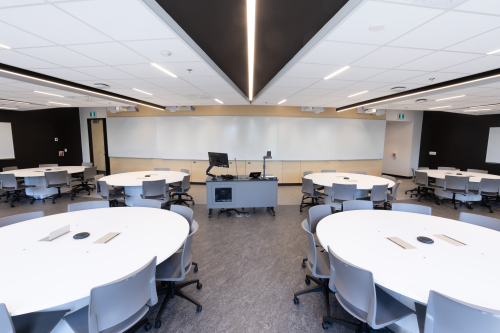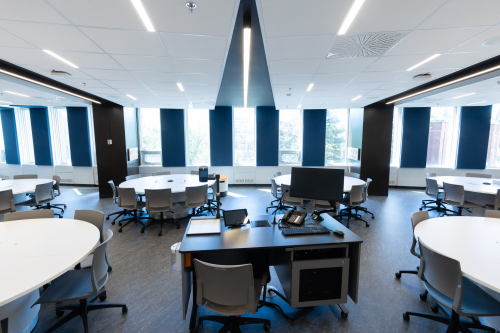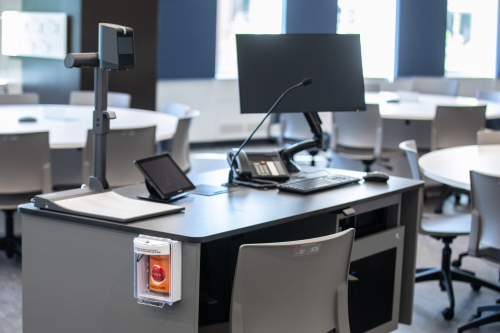- Location: 3655 Promenade Sir William Osler, Montreal, QC
- Capacity: 88 students
- Type: Active learning classroom
Alignment with principles for designing Teaching and Learning Spaces
Academic challenge
Promote individual, active engagement with content.
Layout
Students can work individually or in groups at large, round tables with a work surface for classroom materials (e.g., notebooks, laptops, textbooks).
Furniture
Comfortable, adjustable, ergonomically approved chairs with wheels permit rapid transitions between individual and group learning activities. Whiteboards on the walls facilitate group work.
Technologies
Access to resources: Lecture recording permits individual review of course materials after attending class. Access to infrastructure: Some electrical plugs for student laptops at each table. Multiple sources (local PC, document camera) and screens for simultaneous display of different learning materials.
Lighting & colour
Natural and overhead lighting permits individual work. Blue and yellow accents brighten the room.

Learning with peers
Promote active engagement with one another.
Layout
Round tables permit students to collaborate with one another and move easily from small group (2, 4, or 8 students) to whole class activities. Students can move about easily in the classroom due to sufficient passing space. Sight lines are unobstructed
Acoustics: Sound zones support multiple simultaneous conversations among students.
Furniture
Comfortable, adjustable-height chairs on wheels permit students to turn to discuss and work with those next to or behind them. Armless chairs allow students to easily turn and discuss in pairs or small groups, supporting collaborative learning.
Technologies
Large whiteboards situated at the back of the classroom facilitate group work. Power outlets at each table allow students to keep their computers charged during class.
Lighting & colour
Different lighting patterns and levels support different learning activities.

Experiences with faculty
Promote interaction and communication.
Layout
Instructor’s podium is located at the centre of the room and has plenty of space for all equipment and for the instructor’s materials. The instructor has access to all students due to a layout that permits ample passing space, and clear sightlines.
Acoustics: Sounds zones ensure that not only are students able to hear the instructor, but that the instructor is also able to hear the students. Sounds zones support multiple simultaneous conversations. The instructor has a wireless and a wired microphone available. Student tables have microphones.
Furniture
The podium provides ample space for instructional materials and technology, and has a height adjustment for accessibility and convenience. Mobile chairs support different teaching strategies. Tables have sufficient space surrounding them for the instructor to check in with a given group.
Technologies
Classroom technologies (e.g., local PC, laptop connection, document camera) permit display of different learning materials. Dual-source projecting on multiple projecting surfaces around the classroom permit the display of different learning materials at the same time.
Lighting & colour
Lighting patterns support multiple types of teaching tasks.

Contributions to the campus environment
Classrooms that incorporate elements of active and collaborative learning are part of a vision for a variety of flexible campus learning spaces. This room is designed for all populations using the space: well-lit, with a standardized room control panel that simplifies instructors’ use of equipment in classrooms across campus. IT is consistent with teaching and learning needs, and durable furniture contributes to sustainability efforts. Both physical and virtual affordances help maximize High Impact Practices (HIPs) for student learning within and beyond this classroom.
